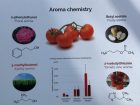
Features
Business
Research
A new greenhouse tomato for all to love
August 22, 2017 By Lilian Schaer AgInnovation
Aug. 23, 2017, Vineland Station, Ont. – There’s a plant inside the greenhouse at Vineland Research and Innovation Centre (Vineland) that could change the tomato eating experience forever.
It is part of ongoing research by a Vineland team of plant breeders, biochemists and consumer specialists to discover a more flavourful greenhouse tomato.
It turns out that only about 60 per cent of consumers are satisfied with the flavour of one of the standard tomatoes grown by most commercial greenhouse growers – five tomatoes on a cluster attached to a section of vine.
“Flavour is a complex trait – tomatoes are amazing chemical factories and that’s what determines their flavour,” explains Vineland biochemistry research scientist David Liscombe. “There is great range in their flavour and although a lot of that is determined by genetics, the environment impacts the chemistry as well.”
Vineland’s consumer insights team worked with consumers and a trained sensory panel of professional tasters to find out what people think is a good flavour and to define the most desired tomato attributes.
A preference map was developed to understand drivers of consumer liking and determine which biochemistry is behind the attributes that drive that liking.
“Texture is critical. If a tomato is mealy and squishy, it wipes out great flavour, aroma and aftertaste, so we have to focus on texture first and then the other aspects,” Liscombe said. “We are looking for a tomato that 100 per cent of consumers will like, not just 60 per cent.”
Researchers then developed a “fingerprint” or picture of the ideal flavourful tomato and applied that to their breeding program – Vineland inherited Agriculture and Agri-Food Canada’s tomato germplasm collection – to match those attributes with characteristics important for growers and retail.
That includes how well plants grow, how much crop they produce and of what quality and appearance, and how well the tomatoes hold up to storage and handling in their journey from vine to consumer.
The program started in 2013 and the first full greenhouse of 75 different hybrid varieties – top selections for flavour crossed with the top agronomic selections – is now starting to produce a crop.
“This is very exciting. The next tomato on the vine that consumers are going to love is in this greenhouse,” Liscombe said. “It’s early days yet but we already have a first crate of fruit to analyze.”
The team will evaluate each individual hybrid for yield, shape, size, architecture, appearance of the clusters, and fruit consistency before going back to the taste testers with the top five or 10 to validate the taste profile.
This fall, seeds from these hybrid lines will be distributed to Ontario greenhouse tomato growers – most production is centred in the Leamington area – so they can begin testing them in their commercial greenhouses.
“A huge part of our breeding program is local adaptation – developing tomatoes that will do well in our environment, and flavour was the start,” Liscombe explained. “We have a continual focus on what the industry wants.”
Lilian Schaer is editor of AgInnovation Ontario, an online publication of the Agri-Technology Commercialization Centre (ATCC), which is based in Guelph, Ontario.
Photos courtesy AgInnovation Ontario
Print this page


